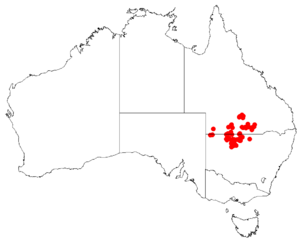Hakea ivoryi facts for kids
Quick facts for kids Hakea ivoryi |
|
|---|---|
| Scientific classification | |
| Genus: |
Hakea
|
| Species: |
ivoryi
|
 |
|
| Where Ivory's Hakea grows in Australia | |
The Ivory's Hakea (scientific name: Hakea ivoryi) is a special kind of shrub or small tree. It's also known as the corkwood or corkbark tree because of its unique bark. This plant belongs to the Proteaceae family, which includes many other interesting plants. You can find it only in certain parts of Queensland and New South Wales in Australia. It's endemic to these areas, meaning it naturally grows nowhere else in the world.
Contents
What Does Ivory's Hakea Look Like?
Ivory's Hakea usually grows as a shrub or a small tree. It can reach a height of about 2 to 12 meters (that's about 6 to 39 feet) tall. Its young branches are covered in soft, white, silky hairs, which become smooth as they get older. This plant has a special woody swelling at its base called a lignotuber. This helps it regrow after a fire.
Leaves, Bark, and Flowers
The leaves of the Ivory's Hakea are like long needles, about 3 to 18 centimeters (1 to 7 inches) long. When they are young, they also have silky hairs, but these disappear as the leaves get older. Younger trees often have leaves that are deeply divided into segments. The bark of this tree is brown, rough, and feels corky, which is why it's sometimes called the "corkbark tree."
The flowers of the Ivory's Hakea are a beautiful white-cream color. They grow in groups of 20 to 50 flowers on short stems. You can usually spot them appearing where the leaves meet the stem. These flowers bloom from October to January, which is during the spring and summer months in Australia.
Fruit and Seeds
After the flowers, the plant produces smooth, egg-shaped fruits. These fruits are about 25 to 35 millimeters (1 to 1.4 inches) long and 10 to 15 millimeters (0.4 to 0.6 inches) wide. Each fruit ends with a short, beak-like tip. Inside these fruits are the seeds, ready to grow into new Hakea plants.
How Ivory's Hakea Got Its Name
The scientific name Hakea ivoryi was first officially described in 1901. A botanist named Frederick Manson Bailey wrote about it in his work called The Queensland Flora. He named the plant after William Ivory. William Ivory was the person who collected samples of this plant for Frederick Bailey to study. This is a common way new plants get their scientific names, honoring the people who helped discover or collect them.
Where Does Ivory's Hakea Grow?
You can find Ivory's Hakea growing in specific areas of Australia. It often grows scattered or in small groups. These plants prefer sandy plains or loamy soil. They are usually found in open, dry woodlands. Their main habitats are in the Bourke and Wanaaring districts of New South Wales. They also grow in the south-western region of Queensland. These areas are often quite arid, meaning they are very dry.

